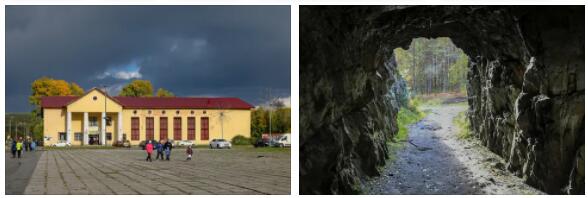In addition to Zaonezhye, in the Medvezhyegorsk region northwest of Medvezhyegorsk, on the Segozero reservoir, there is a historical area of residence of the Segozero Karelians with villages where historical buildings have been preserved. North-east of the Povenets Bay there is a place where the Vygoretskaya hermitage once flourished. Since the end of the 17th century, this region has been the center of the Old Believers. Vygoretskaya Hermitage was founded in 1694 by the Old Believers-schismatics, who arrived here from the Solovetsky Monastery and other monasteries in the northern part of the state. Over time, it turned into a whole republic. The Old Believer Danilovsky Monastery became the center of the desert. At the end of the 19th century, the ever-increasing power of the Vygoretskaya desert led to persecution by the state. Now, on the site of a once flourishing monastery, there is a small village of Danilovo with a chapel and several ancient villages with ancient buildings.
In the western part of the Republic of Karelia, next to the Medvezhyegorsk district, there is the Muezersky district.. The West Karelian Upland passes through its territory, from where many rivers originate, including large ones – the Suna and the Chirka. The area is popular among lovers of extreme tourism, especially among lovers of river rafting. In the southern part of the Muezersky district, 20 km from the village of Sukkozero, there is the highest point of the West Karelian Upland – the legendary mountain Vottovaara with a height of 417.1 m. At its top there was an ancient Saami sanctuary, the southernmost in Russia. Here, on an area of approximately 6 square meters. km, about 1600 cult stones have been preserved. Also on the mountain is an interesting stone staircase leading to one of the rocks. The slopes of the mountain are covered with forests, in which you can see a variety of geological formations.
According to campingship, 100 km north of Medvezhyegorsk, on the western shore of Lake Vygozero, at the confluence of the Segezha River, is the city of Segezha. Since ancient times, the trade route from Veliky Novgorod to the White Sea passed through Vygozero and the Vyg River. Now these water bodies are the largest hydraulic structures of the White Sea-Baltic Canal. In the city of Segezha, the Museum Center, which was founded in 1999, is interesting. It tells about the culture of Vygozerye, the history of the Vygozero part of the trade route from Veliky Novgorod to the White Sea, the history of the construction of the White Sea Canal and the events of the Great Patriotic War. The museum’s collections contain ethnographic and numismatic items, as well as documentary data on the history of the city. The village of Nadvoitsy is located 16 km north of Segezha. In its vicinity, on the Nizhny Vyg River, there is a dry Voitsky Padun waterfall. One of the first gold mines in Russia is located not far from here. It was discovered at the end of the 17th century on the right bank of the Nizhny Vyg River. Pyrite, talc, ocher, copper blue and green, mirror spar, native copper and gold were mined here. However, the production was so small that in 1794 the mine was closed.
On the shores of the Onega Bay of the White Sea is the city of Belomorsk . Primitive people appeared in these places as early as the 4th millennium BC. The first mention of a settlement on the coast of the White Sea at the mouth of the Vyg River dates back to 1419. The settlement was called Soroka. It was from here that in the first half of the 15th century Saints Savva and Herman (the founders of the Solovetsky Monastery) went to the Solovetsky Islands. In 1919, a railway was built to the village of Soroka, and in 1933 the last lock of the White Sea-Baltic Canal was built here. In 1938, the village, along with nearby villages and villages, was merged into the city of Belomorsk. Today Belomorsk is a small town with several hydroelectric power stations. Of the sights, one can single out only the regional museum of local lore “Belomorskiye petroglyphs”. The museum tells about the history of the region, about the material and spiritual culture of the Pomors and about the marine crafts of the local population.
9 km from Belomorsk, at the mouth of the Vyg River, on the rocks of small islands in the middle of its channel, in 1926, Belomorsk petroglyphs were found. The islands are located near the village of Vygostrov and the village of Zolotets. The age of the rock paintings is 6000 years. The White Sea petroglyphs include over 2000 engravings depicting individual figures, boats, scenes of hunting, ritual processions and wars. This is the largest accumulation of petroglyphs in the European part of Russia.. The most popular and easily accessible group of images is Besovy Sledki. It got its name because of the petroglyphs depicting Bes and a chain of eight prints of his feet. It is believed that it was Bes who was revered as the owner of these places, and it was at his image that sacrifices were made. The largest petroglyphs are located 1.5 km northwest of Besovye Sledkov – in Old and New Zalavruga and Yerpin Pudas. The sizes of carved figures of deer here reach 2.5 m. In the course of research, more than 50 sites of ancient people were found next to petroglyphs.
